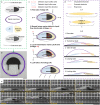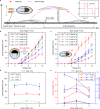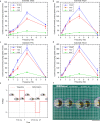Legless soft robots capable of rapid, continuous, and steered jumping
- PMID: 34876570
- PMCID: PMC8651723
- DOI: 10.1038/s41467-021-27265-w
Legless soft robots capable of rapid, continuous, and steered jumping
Abstract
Jumping is an important locomotion function to extend navigation range, overcome obstacles, and adapt to unstructured environments. In that sense, continuous jumping and direction adjustability can be essential properties for terrestrial robots with multimodal locomotion. However, only few soft jumping robots can achieve rapid continuous jumping and controlled turning locomotion for obstacle crossing. Here, we present an electrohydrostatically driven tethered legless soft jumping robot capable of rapid, continuous, and steered jumping based on a soft electrohydrostatic bending actuator. This 1.1 g and 6.5 cm tethered soft jumping robot is able to achieve a jumping height of 7.68 body heights and a continuous forward jumping speed of 6.01 body lengths per second. Combining two actuator units, it can achieve rapid turning with a speed of 138.4° per second. The robots are also demonstrated to be capable of skipping across a multitude of obstacles. This work provides a foundation for the application of electrohydrostatic actuation in soft robots for agile and fast multimodal locomotion.
© 2021. The Author(s).
Conflict of interest statement
The authors declare no competing interests.
Figures






Similar articles
-
A Versatile Soft Crawling Robot with Rapid Locomotion.Soft Robot. 2019 Aug;6(4):455-467. doi: 10.1089/soro.2018.0124. Epub 2019 Mar 18. Soft Robot. 2019. PMID: 30883283
-
Power Amplification for Jumping Soft Robots Actuated by Artificial Muscles.Front Robot AI. 2022 Mar 3;9:844282. doi: 10.3389/frobt.2022.844282. eCollection 2022. Front Robot AI. 2022. PMID: 35308461 Free PMC article.
-
Simple and Fast Locomotion of Vibrating Asymmetric Soft Robots.Soft Robot. 2023 Dec;10(6):1199-1208. doi: 10.1089/soro.2022.0209. Epub 2023 Jul 20. Soft Robot. 2023. PMID: 37471204
-
A Survey of Bioinspired Jumping Robot: Takeoff, Air Posture Adjustment, and Landing Buffer.Appl Bionics Biomech. 2017;2017:4780160. doi: 10.1155/2017/4780160. Epub 2017 Sep 14. Appl Bionics Biomech. 2017. PMID: 29311756 Free PMC article. Review.
-
Lateral Oscillation and Body Compliance Help Snakes and Snake Robots Stably Traverse Large, Smooth Obstacles.Integr Comp Biol. 2020 Jul 1;60(1):171-179. doi: 10.1093/icb/icaa013. Integr Comp Biol. 2020. PMID: 32215569 Review.
Cited by
-
Snapping for 4D-Printed Insect-Scale Metal-Jumper.Adv Sci (Weinh). 2024 Jan;11(3):e2307088. doi: 10.1002/advs.202307088. Epub 2023 Nov 23. Adv Sci (Weinh). 2024. PMID: 37997200 Free PMC article.
-
Bioinspired 3D flexible devices and functional systems.Natl Sci Rev. 2023 Dec 13;11(3):nwad314. doi: 10.1093/nsr/nwad314. eCollection 2024 Mar. Natl Sci Rev. 2023. PMID: 38312384 Free PMC article. Review.
-
Design of Heavy-Load Soft Robots Based on a Dual Biomimetic Structure.Biomimetics (Basel). 2024 Jun 30;9(7):398. doi: 10.3390/biomimetics9070398. Biomimetics (Basel). 2024. PMID: 39056839 Free PMC article.
-
Soft and lightweight fabric enables powerful and high-range pneumatic actuation.Sci Adv. 2023 Apr 14;9(15):eadg1203. doi: 10.1126/sciadv.adg1203. Epub 2023 Apr 12. Sci Adv. 2023. PMID: 37043577 Free PMC article.
-
Snapping for high-speed and high-efficient butterfly stroke-like soft swimmer.Sci Adv. 2022 Nov 16;8(46):eadd3788. doi: 10.1126/sciadv.add3788. Epub 2022 Nov 18. Sci Adv. 2022. PMID: 36399554 Free PMC article.
References
-
- Zhang C, Zou W, Ma L, Wang Z. Biologically inspired jumping robots: a comprehensive review. Robot. Auton. Syst. 2020;124:103362. doi: 10.1016/j.robot.2019.103362. - DOI
-
- Kovač, M., Fuchs, M., Guignard, A., Zufferey, J. & Floreano, D. A miniature 7 g jumping robot. In IEEE International Conference on Robotics and Automation 373–378 (IEEE, 2008).
-
- Kovač M. The bioinspiration design paradigm: a perspective for soft robotics. Soft Robotics. 2014;1:28–37. doi: 10.1089/soro.2013.0004. - DOI
Publication types
LinkOut - more resources
Full Text Sources

